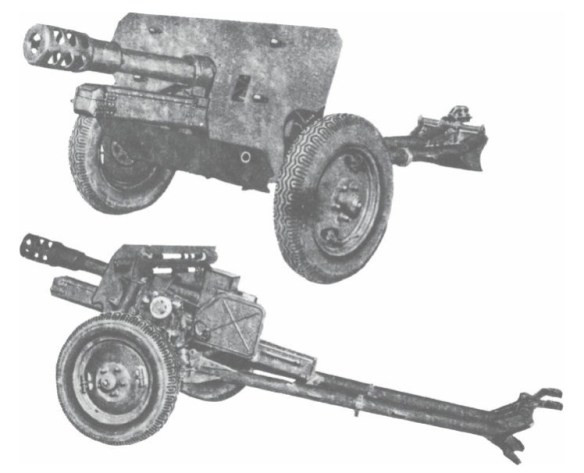7.5cm IG 42 (Grauwolf)
The Krupp prototype of the IG 42, later distinguished as the IG 42 aA.
After the 1940 campaigns the infantry felt that the IG 38 was outdated, and so they requested a weapon with greater range and a much better anti-tank capability; the hollow charge shell had not then been introduced and they were using the normal high explosive shell as an anti-tank projectile.
In response to this demand, Krupp designed the 7.5cm IG 42, an efficient-looking weapon with tubular split trail, pneumatic tyres, a shield and a cage-type muzzle brake. Although the result was a serviceable weapon, production capacity was not readily available-and since the introduction of the hollow charge shell had by then given the IG 18 a reasonable anti-tank performance, the IG 42 project was dropped.
Later experience in the Russian campaigns, however, convinced the infantry that a new weapon was definitely needed and in 1944 the project was revived. The original design was thereafter called IG 42 aA (alterer Art, or `old pattern’) in order to avoid confusion, and the slightly modified gun was mounted on a lightweight split-trail carriage that had been designed a short time previously by Rheinmetall-Borsig for the 8cm PAW 600 antitank gun; the carriage, being a simple design, could be put into production quickly and easily.
The gun was exactly the same as that described for the IG 37, and the carriage was the only difference between the equipments. A severely angled shield was fitted and the wheels were of disc pattern, with either solid or pneumatic tyres. The spring suspension was achieved by stubaxles and torsion bars were incorporated.
Data
Calibre: 75mm/2.95in.
Length of gun: 1798mm/70.77in.
Length of bore: 1424mm/56.04in.
Rifling: 24 grooves, right-hand uniform twist, 1/25.59.
Traverse: 60°. Elevation: -6° to +32°.
Breech mechanism: vertical sliding block, semiautomatic, percussion firing.
Weight in action: 590kg/1301lb.
Performance
As the IG 37, except that owing to the lower maximum elevation the maximum range was lower- 4600m(5030yd)-though, with the trail spades buried, it was possible to reach 5150m(5632yd).
Ammunition
As the IG 37.
Towards the end of the war much development work was done on fin-stabilised hollow charge and high-capacity high explosive (Minen) shells, outlined in the sections on development. The 7.5cm IG 42 was selected as a potential vehicle for this type of ammunition, and a smoothbore version with an improved muzzle brake was built at the Hillersleben test range in order to undertake trials with various projectile designs. Had the war continued, the gun might have been farther developed into a service weapon.
